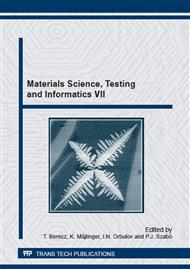p.297
p.303
p.309
p.315
p.321
p.327
p.333
p.339
p.345
Residual Stress in Plain Carbon Steel Induced by Laser Hardening
Abstract:
Technological residual stresses have great importance in the manufacturing processes and the lifetime of components. The residual stresses formed by quenching can be very diverse because of its multiple sources. Alternative quenching processes such as laser hardening have a great potential for different applications. The direction of heat transfer during laser hardening is the opposite compared to conventional quenching. This further increases the complexity of the developed stress state. The residual stress profile and the microstructure formed by laser hardening treatment are investigated in the present manuscript.
Info:
Periodical:
Pages:
321-326
Citation:
Online since:
February 2015
Authors:
Price:
Сopyright:
© 2015 Trans Tech Publications Ltd. All Rights Reserved
Share:
Citation:


